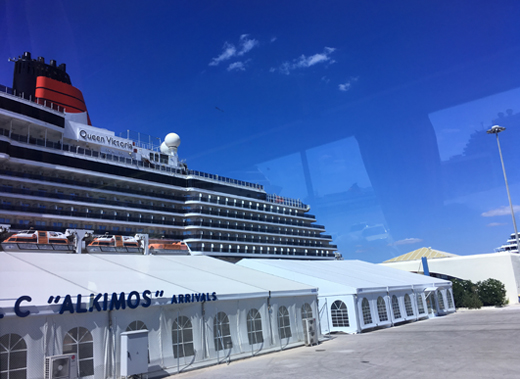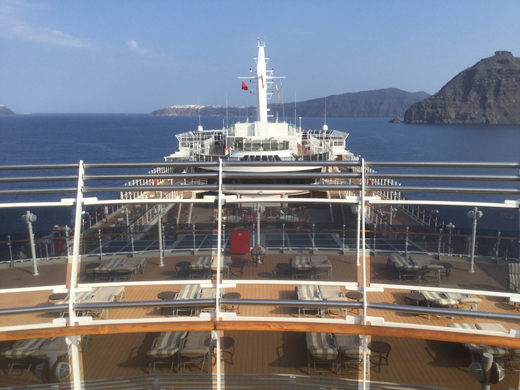
I'm back, several pounds heavier following a seven-day cruise aboard Cunard's Queen Victoria.
If, like me, you have no interest in physical activity and enjoy eating, drinking and doing very little, it's inevitable you'll put on even more weight during a cruise.
Breakfast, lunch, afternoon tea and dinner are on a continuous loop. For the weak-willed there's no escape from the calories and the cholesterol.
This was our fifth cruise and our second on the Queen Victoria. We like it because it's not as big as many modern cruise ships, most of which are designed to attract families with hyperactive children (teenagers and toddlers), hence the climbing walls, ice rinks, outdoor cinemas and God knows what.
On the Queen Victoria children are relatively few in number. I also like the fact that Cunard's boats are still recognisably ships rather than Las Vegas style floating hotels.
I won't bore you with too many details. Suffice to say we joined the ship in Venice and thereafter visited Dubrovnik (Croatia), Saranda (Albania), Heraklion (Crete) and Santorini (Greece).
The famous walled city of Dubrovnik, which I first visited in 1972, was a bit of a disappointment – far too many tourists.
Cruise ships don't help because thousands of passengers descend on the city like a swarm of ants, arriving and departing within a few hours. People like me are therefore part of the problem.
In contrast a friend rented a villa overlooking Dubrovnik earlier this year and had a great time, enjoying superb views and picking his moment to wander around this historic city.
Saranda was very different. In fact we were told it was the first time any Cunard ship had stopped there and the only reason we were there at all was because the company changed the itinerary a few weeks before we left to avoid a scheduled visit to Turkey.
Anyway we didn't spend much time in Saranda itself. Instead we boarded a small coach that took us to an archaeological site about an hour away.
En route our guide gave us a potted history of the country's post war history and explained that Albanians prefer not to pay tax so the state has very little money to spend on infrastructure.
That was painfully obvious. We were told that most Albanians can't get a loan so homes and other buildings have to be paid for in cash. The result is that a huge number of offices and apartments are unfinished.
They build and then occupy the ground floor but if there's no more money construction stops. Sometimes there's enough to erect the frame of the building – three or four floors – but not enough to do anything else so it sits there, empty and apparently derelict.
From our coach we saw hundreds of buildings like that.
The archeological site was interesting, if you like that sort of thing. The ancient buildings unearthed by the Italians in the decade before the Second World War had been built by the Venetians and the the Romans.
Apparently there are many more buildings still to be excavated but the process is incredibly slow because the Albanians don't have the money to dig any quicker.
Sadly, unlike Greece for example, the Albanians don't have the confidence to sell their own culture as a tourist attraction. Every shop and bar in Saranda seemed to have an English (or American) name or theme.
Understandably perhaps they are desperate to join the EU. As our guide said, Brexit has given them hope there might be a spare place at the table.
Arriving in Crete our noses were immediately put out of joint by the information that the buses that should have transferred us from port to city centre could go no further than the port gates because the local taxi union wouldn't allow it.
Instead we had to get off the coach and choose between walking (in the baking heat) or getting a taxi. Naturally every Brit chose to walk, our white legs and floppy hats signalling our nationality and defiance of that pesky union.
We spent less time in Heraklion partly because it was so hot and I wanted to get back to the comfort of our air-conditioned ship where we heard this from a neighbouring balcony. Angry husband to wife: "We may be in Crete but I'm not a cretin."
The most picturesque part of the cruise was probably Santorini, a Greek island in the southern part of the Aegean.
If I'm honest I'd never heard of it before, which shows how ignorant I am. The current rock formation was created by a huge volcanic eruption so the lagoon where the ship sat at anchor is in fact an enormous crater.
Unionised tender boats took us from ship to shore where a cable car whisked us to the top of a steep 1,000 foot cliff where a small town of whitewashed buildings overlooked the lagoon. This was Fira, the capital, and from a distance those buildings looked like snow on top of a mountain.
Coming down we chose to follow the original zig-zag path. In hindsight this was a mistake because it took us the best part of an hour. (The cable car took three or four minutes.)
We also found ourselves sharing the path with scores of donkeys, a relic of the pre-cable car era. The smell of stinking hot manure was pretty grotesque. I'd recommend Fira (in spring or autumn) but give those steps a miss.
Our final disembarkation was at Piraeus, a few miles south of Athens, where the picture above was taken.
The photo below was taken from deck 12 when the ship was at anchor in the lagoon at Santorini.
Miraculously for a cruise ship it was 11.00am and we were the only people on that particular deck. This meant we had our own personal waiter who scurried to and fro bringing us cold drinks, plates of melon and other refreshments. We didn't even have to ask.
And on that note, it's back to work.
